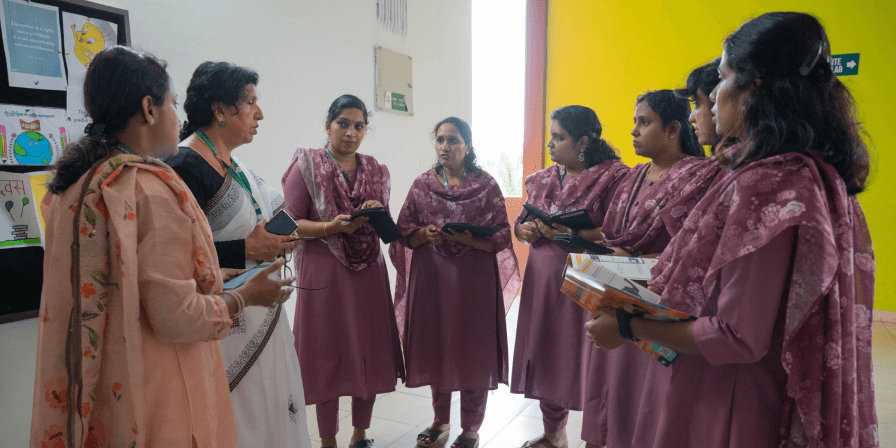The Role of Peer Learning in Teacher Training: Key Insights, Benefits, and Practical Approaches

The Role of Peer Learning in Teacher Training: Key Insights, Benefits, and Practical Approaches
Last Updated On: 19/02/2025
rohit chavan
Teachers
What is Peer Learning, and Why Does It Matter?
Peer learning is an educational approach where individuals learn from one another by sharing experiences, knowledge, and skills. Unlike traditional teacher-led instruction, peer to peer teaching strategies create an environment of mutual learning where everyone is both a teacher and a learner.
In the context of teacher training, peer learning encourages educators to exchange best practices, reflect on teaching methodologies, and collaborate on problem-solving. This not only enriches their expertise but also builds a strong community of professional educators.
Why Peer Learning is Transformative in Teacher Training?
Peer learning holds immense value in the professional development of teachers. Below are some key reasons why this approach is crucial:
1. Encourages Deeper Understanding
Through peer discussions and feedback, teachers can analyze and refine their teaching techniques, leading to a deeper understanding of instructional strategies.
2. Fosters Critical Thinking
When educators engage in peer learning activities in the classroom, they are encouraged to evaluate their approaches holistically. This results in more effective problem-solving and teaching outcomes.
3. Strengthens Collaborative Skills
Peer learning helps teachers learn the importance of teamwork, negotiation, and shared decision-making, all of which are essential for fostering a positive school culture.
4. Boosts Confidence
Teachers often gain confidence when they successfully contribute to their peers’ learning or implement ideas gained from collaboration.
5. Promotes Diverse Perspectives
By interacting with peers from various backgrounds and teaching experiences, educators gain insights into different teaching styles, tools, and techniques.
6. Builds Empathy and Understanding
Peer learning fosters a sense of community and empathy as teachers share their challenges and triumphs, cultivating mutual support and encouragement.
The Key Benefits of Peer Learning in Teacher Training
1. Active Engagement in Learning
Peer learning helps teachers transition from being passive recipients to active participants in their professional development, leading to more meaningful outcomes.
2. Increased Motivation
When educators collaborate and achieve goals together, they are more motivated to explore innovative teaching practices.
3. Personalized Learning Experiences
With peer-assisted learning strategies, training can be tailored to the individual needs of educators, making the experience more effective and relevant.
4. Enhanced Communication Skills
Peer learning improves communication by encouraging open dialogue, feedback, and discussions, which are vital for effective teaching.
5. Long-lasting Knowledge Retention
Collaborative learning ensures that knowledge gained is reinforced through discussions and real-world applications, leading to better retention.
6. Better Preparation for Real-world Challenges
By working through real-life scenarios and sharing their experiences, teachers can better address challenges in their classrooms.
Never miss a story
Stay updated with the latest news and articles related to school education
GIVE YOUR SCHOOL THE LEAD ADVANTAGE
NEP 2020 Recommendations for Teacher Training & Peer Learning
- Continuous Professional Development (CPD) – NEP 2020 emphasizes the need for at least 50 hours of professional training per year for teachers, encouraging peer learning, mentoring, and collaborative teaching approaches.
- Teacher Collaboration & Peer Support – The policy highlights the importance of peer-assisted learning strategies to improve pedagogy, assessment techniques, and classroom management.
- Technology-Enabled Peer Learning – NEP 2020 promotes the use of digital platforms and online communities for teachers to share resources, discuss best practices, and learn collaboratively.
NCF 2023 Recommendations for Teacher Training
- Reflective & Experiential Learning – NCF 2023 encourages peer-to-peer teaching strategies where educators co-reflect on classroom experiences and engage in hands-on learning.
- School-Based Professional Learning Communities (PLCs) – Teachers should actively participate in collaborative lesson planning, peer observations, and feedback sessions to improve teaching effectiveness.
- Peer Learning for Inclusive Education – Teachers are encouraged to work in groups to develop inclusive teaching strategies, ensuring education is accessible to all students, including those with diverse learning needs.
Effective Approaches to Peer Learning in Teacher Training
Incorporating peer learning into teacher training can be achieved through several practical methods:
1. Peer Tutoring
Teachers can pair up to mentor one another in areas where they have expertise. For instance, an experienced teacher might guide a novice on classroom management techniques.
2. Collaborative Projects
Group projects such as creating lesson plans or designing interactive teaching tools encourage teamwork and creative thinking.
3. Peer Review
Reviewing each other’s lesson plans or teaching methods provides valuable feedback and fosters improvement.
4. Discussion Groups
Organized discussions allow teachers to share their insights and challenges, sparking new ideas and solutions.
5. Study Partnerships
Forming partnerships for shared learning can lead to a deeper understanding of topics, such as integrating technology in classrooms.
Real-world peer learning examples in Action:
To understand how peer learning can be applied in teacher training, here are some peer learning examples:
- Mentorship Programs:
- Workshops and Seminars:
- Mock Teaching Sessions:
- Online Communities:
Pairing experienced teachers with new educators to share knowledge and strategies.
Group sessions where teachers collaborate on solving classroom challenges or mastering new techniques.
Educators practice teaching in front of their peers and receive constructive feedback to refine their methods.
Virtual forums where teachers can discuss teaching trends, share resources, and learn from one another’s experiences.
Building a Culture of Collaboration in Schools
For peer learning to thrive, schools must create an environment that values collaboration and knowledge-sharing. This includes:
- Encouraging open communication and regular feedback among teachers.
- Providing structured opportunities like workshops and group projects.
- Recognizing and celebrating the achievements of collaborative efforts.
By embracing peer teaching, schools can ensure that teachers are continuously learning and growing, ultimately leading to better outcomes for students.
Conclusion
Peer learning is a powerful tool in teacher training, offering numerous benefits such as improved collaboration, critical thinking, and knowledge retention. By integrating peer to peer teaching strategies and fostering a supportive environment, schools can empower their teachers to achieve professional excellence.
At LEAD Group, we believe in empowering educators with the best training solutions that go beyond conventional methods. Our Teacher Training Courses focus on equipping educators with modern, technology-enabled pedagogies, real-time classroom strategies, and collaborative approaches that include peer learning activities in the classroom. LEAD’s training programs emphasize building a community of well-prepared and confident teachers who can inspire students and drive better learning outcomes.
Whether through mentorship, discussion groups, or collaborative projects, LEAD’s teacher training solutions ensure that every teacher is prepared to face real-world challenges with confidence and skill.
Join LEAD in building a culture of collaboration in your school and watch your educators thrive together while unlocking the true potential of your students.
